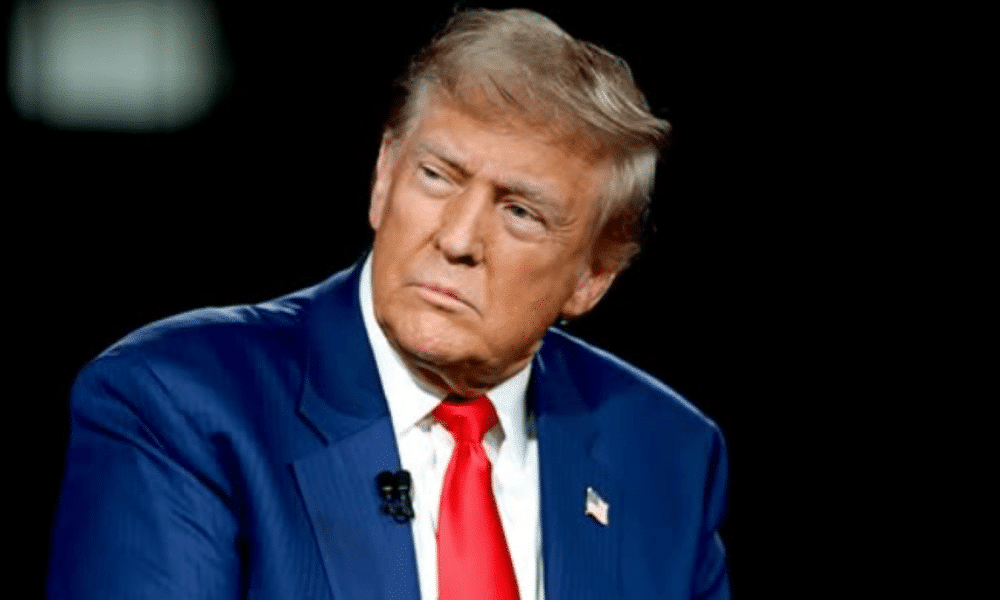Tensions in the Middle East reached a new peak this Friday, April 4, when U.S. President Donald Trump posted a video on social media mocking an American strike against the Houthi rebel group in Yemen. The black-and-white footage shows a bombardment hitting dozens of people gathered together, allegedly rebels planning actions against ships in the Mar Vermelho. Alongside the video, Trump wrote: “These Houthis gathered to receive instructions for an attack. Oops, there’ll be no attack from these Houthis! They’ll never sink our ships again!” The taunt comes amid a military escalation that began in March, with the United States conducting daily airstrikes against Houthi targets, and reflects Trump’s aggressive stance both in foreign policy and in his recent imposition of trade tariffs shaking the global economy.
The U.S. campaign against the Houthis, launched on March 15, has already cost hundreds of millions of dollars in munitions, including Tomahawk cruise missiles and GPS-guided bombs. The effort aims to weaken the rebels’ military capabilities, which have intensified attacks on commercial vessels in the Mar Vermelho since late 2023 in retaliation for Israel’s operations in the Gaza Strip. Backed by Iran, the Houthis control Yemen’s capital, Sanaa, and other strategic areas, using drones, missiles, and boats to challenge international shipping, prompting the U.S. to bolster its military presence in the region with a second aircraft carrier.
Meanwhile, Trump’s decision to impose reciprocal tariffs on dozens of countries, including allies, has triggered an economic crisis reflected in falling global stock markets. Announced earlier this week, the measures include a baseline 10% tax on all imports, with steeper rates like 34% on Chinese goods and 25% on foreign vehicles. Dubbed a “tariff blowout” by the president, the policy has drawn domestic and international criticism, with experts warning of inflation and recession risks in the U.S., alongside trade retaliations from partners like China and Canada.
Airstrikes in Yemen take a provocative turn
Trump’s video isn’t just a show of military might—it’s also an attempt to bolster his image as a tough leader for a divided domestic audience. The footage, likely captured by drones or surveillance aircraft, depicts the destruction of an alleged Houthi meeting point, though rebel officials have disputed the claim, asserting the strike hit a tribal gathering with no military purpose. Since the offensive began in mid-March, the U.S. has carried out over 20 consecutive days of airstrikes, deploying B-2 bombers and long-range missiles from bases like Diego Garcia in the Indian Ocean.
The Houthis, however, remain resilient. Despite losses, the group keeps arsenals in fortified underground bunkers, limiting the success of the American campaign in neutralizing their capabilities. Data shows that since October 2023, the rebels have conducted dozens of attacks on commercial and military ships in the Mar Vermelho, including downing three U.S. Reaper drones since early March. The escalation underscores the complexity of Yemen’s conflict, where the Houthis have solidified power since 2014, controlling ports, collecting taxes, and diverting humanitarian aid.
Earlier this week, Trump doubled down on his stance, declaring that airstrikes would continue until the Houthis cease threatening freedom of navigation. “Stop shooting at our ships, and we’ll stop shooting at you,” he said in a speech on Monday, March 31, also warning Iran, the group’s main backer, of harsher consequences if support persists. The message came with the announcement of a second aircraft carrier deployment to the Middle East, raising U.S. naval presence in the region to levels rarely seen in recent years.
Tariffs shake economy and spark global backlash
Alongside the military push, Trump faces a crisis fueled by his trade policy. On Wednesday, April 2, the president signed an executive order imposing widespread tariffs, aiming to “reset global trade relations.” The measure slaps a 10% tax on all imports, with specific rates like 34% on Chinese goods, 20% on European Union products, and 25% on foreign vehicles. The decision triggered a nearly 5% drop in the S&P 500 on Thursday, the steepest since June 2020, and raised fears of a full-scale global trade war.
China swiftly retaliated, announcing 34% tariffs on U.S. goods starting April 10, alongside restrictions on rare earth exports critical for electronics and electric vehicles. Canada followed suit, imposing new taxes on American vehicles, while the European Union hinted at suspending investments in the U.S. market. In the UK, automaker Jaguar Land Rover halted shipments to the U.S. to offset the 25% vehicle tax impact.
Domestically, the tariffs lack widespread support. Recent polls show most Americans oppose the measure, fearing price hikes on consumer goods like electronics, clothing, and food. Economists predict the “tariff blowout” could drive up costs for items like iPhones by as much as $2,300 if production isn’t shifted stateside—a move deemed unfeasible in the short term due to insufficient infrastructure and skilled labor.
Background of the Houthi conflict
The clash with the Houthis stems from a civil war ravaging Yemen for over a decade. The Shia-origin group seized Sanaa in 2014, forcing the internationally recognized government to retreat south. Since then, the rebels have received logistical and military support from Iran, including ballistic missiles and advanced drones. Starting in October 2023, the Houthis ramped up Mar Vermelho attacks, targeting ships linked to Israel in solidarity with Hamas, prompting U.S. intervention to safeguard vital trade routes.
The American campaign, launched on March 15, has consumed roughly $200 million in munitions, per Pentagon estimates. B-2 bombers from the British-American base in Diego Garcia have struck strategic targets, while Navy ships like the USS Gettysburg fire precision strikes. Despite the damage inflicted, the Houthis remain operational, using guerrilla tactics and underground stockpiles to preserve their military strength.
The deployment of two U.S. aircraft carriers in the Middle East, announced this week, reflects the situation’s gravity. The enhanced naval presence enables more frequent and sustained strikes but also escalates operation costs, nearing $1 billion with personnel and logistics included. The strategy seeks to restore Mar Vermelho security, through which about 12% of global maritime trade flows, but faces criticism for its limited success so far.
Global reactions to Trump’s tariffs
Trump’s reciprocal tariffs have sparked a wave of international responses. China, the primary target, set its 34% tariffs on U.S. goods to begin April 10, impacting exports like corn, beef, and poultry worth $24.65 billion in 2024. Beijing also imposed rare earth export controls, a move that could disrupt the global tech industry.
Canada’s new vehicle tariffs aim to shield its auto sector, while the European Union considers halting U.S. market investments in response to the 20% tax on its goods. French President Emmanuel Macron urged French firms to pause U.S. operations, and the UK grapples with Jaguar Land Rover’s export suspension. Even nations like Venezuela face secondary 25% tariffs on countries buying its oil or gas.
Stock markets reflect the immediate fallout. Thursday saw significant losses in the U.S., with Tokyo, London, and Paris also hit hard. Analysts warn that escalating tariffs could trigger a global recession, with rising prices and supply chain disruptions, especially in import-reliant sectors like technology and automotive.
Timeline of military and trade escalation
Recent events highlight how Trump’s actions in Yemen and global trade intertwine. Key moments include:
- March 15: U.S. begins airstrikes against Houthis in Yemen.
- March 31: Trump threatens intensified attacks and deploys second aircraft carrier to Middle East.
- April 2: Executive order imposes reciprocal tariffs on over 180 countries.
- April 3: Global stock markets fall as nations announce trade retaliations.
- April 4: Trump posts video mocking Houthi strike.
This timeline underscores the rapid pace of U.S. moves on both fronts under Trump’s leadership.
Domestic challenges and Houthi resilience
In the U.S., the tariff policy faces stiff opposition. The S&P 500 drop and inflation forecasts pressure Trump, whose approval ratings are already strained by rising living costs. Experts note that mass production of goods like footwear and electronics can’t shift to the U.S. quickly, likely leading to higher consumer prices.
In Yemen, the Houthis show adaptability. After over three weeks of airstrikes, the group downed a third U.S. Reaper drone in March, proving its air defenses remain active. Rebel leaders have been killed and facilities damaged, but most of their arsenal stays safe in bunkers, hampering U.S. efforts to fully neutralize them.
Iran’s support fuels Houthi resilience, providing missile and drone technology. Despite the strikes, the rebels hold Sanaa and key maritime routes, continuing to defy navigation in the Mar Vermelho. The U.S. campaign has inflicted losses but hasn’t stopped ship attacks, raising questions about its long-term effectiveness.
Economic fallout of U.S. tariffs
Trump’s tariffs are already reshaping the American market. Companies like Jaguar Land Rover, pausing exports, suggest others may follow, cutting the supply of imported goods. Economists estimate price hikes for items like smartphones, clothing, and vehicles, eroding consumer purchasing power.
- Electronics: iPhones could hit $2,300 with taxes on Chinese components.
- Vehicles: Imported cars face a 25% increase, affecting popular brands.
- Food: Tariffs on meat and grains will raise supermarket prices.
These spikes could fuel inflation, a growing concern after years of relative stability in the U.S.
Military pressure and Houthi strategies
The U.S. offensive in Yemen employs advanced weaponry, like JASSM and JSOW missiles, fired by B-2 bombers and Navy ships. The USS Gettysburg has been key in precision strikes since March. Yet, the Houthis adapt, hiding gear in bunkers and using cheap drones to counterattack, raising U.S. operation costs without decisive results.
The group also maintains a strong public narrative, posing as defenders of the Palestinian cause against Israel. This stance garners support in Yemen and beyond, complicating U.S. efforts to isolate them. The two-carrier presence intensifies strikes but doesn’t stop Houthi attacks on ships and U.S. drones.
Iran’s backing to the Houthis has reportedly waned, with Tehran pulling personnel from Yemen to focus on direct U.S. threats. Still, the rebels operate autonomously, using stockpiles and guerrilla tactics to withstand American pressure.
Global landscape after Trump’s moves
Trump’s actions in Yemen and trade place the U.S. at a tense international crossroads. The Friday video taunting the Houthis reinforces his confrontational stance but exposes the limits of a $1 billion military campaign that hasn’t halted rebel attacks. Economically, the tariffs risk sparking a trade war that could harm allies and foes alike, with effects rippling from Tokyo to Washington.
China’s retaliatory tariffs and rare earth controls position it as a key counterweight, while Canada and the UK scramble to mitigate impacts. In the Middle East, U.S. naval presence and ongoing strikes keep the focus on the Houthis, but Yemen’s conflict remains unresolved, with the rebels adapting to each assault.
The second aircraft carrier deployment, announced Monday, underscores Trump’s commitment to projecting military power, but it also heightens risks of a broader clash with Iran or its proxies. Meanwhile, falling stocks and looming price hikes test Trump’s domestic standing, as criticism mounts at home and abroad.

Tensions in the Middle East reached a new peak this Friday, April 4, when U.S. President Donald Trump posted a video on social media mocking an American strike against the Houthi rebel group in Yemen. The black-and-white footage shows a bombardment hitting dozens of people gathered together, allegedly rebels planning actions against ships in the Mar Vermelho. Alongside the video, Trump wrote: “These Houthis gathered to receive instructions for an attack. Oops, there’ll be no attack from these Houthis! They’ll never sink our ships again!” The taunt comes amid a military escalation that began in March, with the United States conducting daily airstrikes against Houthi targets, and reflects Trump’s aggressive stance both in foreign policy and in his recent imposition of trade tariffs shaking the global economy.
The U.S. campaign against the Houthis, launched on March 15, has already cost hundreds of millions of dollars in munitions, including Tomahawk cruise missiles and GPS-guided bombs. The effort aims to weaken the rebels’ military capabilities, which have intensified attacks on commercial vessels in the Mar Vermelho since late 2023 in retaliation for Israel’s operations in the Gaza Strip. Backed by Iran, the Houthis control Yemen’s capital, Sanaa, and other strategic areas, using drones, missiles, and boats to challenge international shipping, prompting the U.S. to bolster its military presence in the region with a second aircraft carrier.
Meanwhile, Trump’s decision to impose reciprocal tariffs on dozens of countries, including allies, has triggered an economic crisis reflected in falling global stock markets. Announced earlier this week, the measures include a baseline 10% tax on all imports, with steeper rates like 34% on Chinese goods and 25% on foreign vehicles. Dubbed a “tariff blowout” by the president, the policy has drawn domestic and international criticism, with experts warning of inflation and recession risks in the U.S., alongside trade retaliations from partners like China and Canada.
Airstrikes in Yemen take a provocative turn
Trump’s video isn’t just a show of military might—it’s also an attempt to bolster his image as a tough leader for a divided domestic audience. The footage, likely captured by drones or surveillance aircraft, depicts the destruction of an alleged Houthi meeting point, though rebel officials have disputed the claim, asserting the strike hit a tribal gathering with no military purpose. Since the offensive began in mid-March, the U.S. has carried out over 20 consecutive days of airstrikes, deploying B-2 bombers and long-range missiles from bases like Diego Garcia in the Indian Ocean.
The Houthis, however, remain resilient. Despite losses, the group keeps arsenals in fortified underground bunkers, limiting the success of the American campaign in neutralizing their capabilities. Data shows that since October 2023, the rebels have conducted dozens of attacks on commercial and military ships in the Mar Vermelho, including downing three U.S. Reaper drones since early March. The escalation underscores the complexity of Yemen’s conflict, where the Houthis have solidified power since 2014, controlling ports, collecting taxes, and diverting humanitarian aid.
Earlier this week, Trump doubled down on his stance, declaring that airstrikes would continue until the Houthis cease threatening freedom of navigation. “Stop shooting at our ships, and we’ll stop shooting at you,” he said in a speech on Monday, March 31, also warning Iran, the group’s main backer, of harsher consequences if support persists. The message came with the announcement of a second aircraft carrier deployment to the Middle East, raising U.S. naval presence in the region to levels rarely seen in recent years.
Tariffs shake economy and spark global backlash
Alongside the military push, Trump faces a crisis fueled by his trade policy. On Wednesday, April 2, the president signed an executive order imposing widespread tariffs, aiming to “reset global trade relations.” The measure slaps a 10% tax on all imports, with specific rates like 34% on Chinese goods, 20% on European Union products, and 25% on foreign vehicles. The decision triggered a nearly 5% drop in the S&P 500 on Thursday, the steepest since June 2020, and raised fears of a full-scale global trade war.
China swiftly retaliated, announcing 34% tariffs on U.S. goods starting April 10, alongside restrictions on rare earth exports critical for electronics and electric vehicles. Canada followed suit, imposing new taxes on American vehicles, while the European Union hinted at suspending investments in the U.S. market. In the UK, automaker Jaguar Land Rover halted shipments to the U.S. to offset the 25% vehicle tax impact.
Domestically, the tariffs lack widespread support. Recent polls show most Americans oppose the measure, fearing price hikes on consumer goods like electronics, clothing, and food. Economists predict the “tariff blowout” could drive up costs for items like iPhones by as much as $2,300 if production isn’t shifted stateside—a move deemed unfeasible in the short term due to insufficient infrastructure and skilled labor.
Background of the Houthi conflict
The clash with the Houthis stems from a civil war ravaging Yemen for over a decade. The Shia-origin group seized Sanaa in 2014, forcing the internationally recognized government to retreat south. Since then, the rebels have received logistical and military support from Iran, including ballistic missiles and advanced drones. Starting in October 2023, the Houthis ramped up Mar Vermelho attacks, targeting ships linked to Israel in solidarity with Hamas, prompting U.S. intervention to safeguard vital trade routes.
The American campaign, launched on March 15, has consumed roughly $200 million in munitions, per Pentagon estimates. B-2 bombers from the British-American base in Diego Garcia have struck strategic targets, while Navy ships like the USS Gettysburg fire precision strikes. Despite the damage inflicted, the Houthis remain operational, using guerrilla tactics and underground stockpiles to preserve their military strength.
The deployment of two U.S. aircraft carriers in the Middle East, announced this week, reflects the situation’s gravity. The enhanced naval presence enables more frequent and sustained strikes but also escalates operation costs, nearing $1 billion with personnel and logistics included. The strategy seeks to restore Mar Vermelho security, through which about 12% of global maritime trade flows, but faces criticism for its limited success so far.
Global reactions to Trump’s tariffs
Trump’s reciprocal tariffs have sparked a wave of international responses. China, the primary target, set its 34% tariffs on U.S. goods to begin April 10, impacting exports like corn, beef, and poultry worth $24.65 billion in 2024. Beijing also imposed rare earth export controls, a move that could disrupt the global tech industry.
Canada’s new vehicle tariffs aim to shield its auto sector, while the European Union considers halting U.S. market investments in response to the 20% tax on its goods. French President Emmanuel Macron urged French firms to pause U.S. operations, and the UK grapples with Jaguar Land Rover’s export suspension. Even nations like Venezuela face secondary 25% tariffs on countries buying its oil or gas.
Stock markets reflect the immediate fallout. Thursday saw significant losses in the U.S., with Tokyo, London, and Paris also hit hard. Analysts warn that escalating tariffs could trigger a global recession, with rising prices and supply chain disruptions, especially in import-reliant sectors like technology and automotive.
Timeline of military and trade escalation
Recent events highlight how Trump’s actions in Yemen and global trade intertwine. Key moments include:
- March 15: U.S. begins airstrikes against Houthis in Yemen.
- March 31: Trump threatens intensified attacks and deploys second aircraft carrier to Middle East.
- April 2: Executive order imposes reciprocal tariffs on over 180 countries.
- April 3: Global stock markets fall as nations announce trade retaliations.
- April 4: Trump posts video mocking Houthi strike.
This timeline underscores the rapid pace of U.S. moves on both fronts under Trump’s leadership.
Domestic challenges and Houthi resilience
In the U.S., the tariff policy faces stiff opposition. The S&P 500 drop and inflation forecasts pressure Trump, whose approval ratings are already strained by rising living costs. Experts note that mass production of goods like footwear and electronics can’t shift to the U.S. quickly, likely leading to higher consumer prices.
In Yemen, the Houthis show adaptability. After over three weeks of airstrikes, the group downed a third U.S. Reaper drone in March, proving its air defenses remain active. Rebel leaders have been killed and facilities damaged, but most of their arsenal stays safe in bunkers, hampering U.S. efforts to fully neutralize them.
Iran’s support fuels Houthi resilience, providing missile and drone technology. Despite the strikes, the rebels hold Sanaa and key maritime routes, continuing to defy navigation in the Mar Vermelho. The U.S. campaign has inflicted losses but hasn’t stopped ship attacks, raising questions about its long-term effectiveness.
Economic fallout of U.S. tariffs
Trump’s tariffs are already reshaping the American market. Companies like Jaguar Land Rover, pausing exports, suggest others may follow, cutting the supply of imported goods. Economists estimate price hikes for items like smartphones, clothing, and vehicles, eroding consumer purchasing power.
- Electronics: iPhones could hit $2,300 with taxes on Chinese components.
- Vehicles: Imported cars face a 25% increase, affecting popular brands.
- Food: Tariffs on meat and grains will raise supermarket prices.
These spikes could fuel inflation, a growing concern after years of relative stability in the U.S.
Military pressure and Houthi strategies
The U.S. offensive in Yemen employs advanced weaponry, like JASSM and JSOW missiles, fired by B-2 bombers and Navy ships. The USS Gettysburg has been key in precision strikes since March. Yet, the Houthis adapt, hiding gear in bunkers and using cheap drones to counterattack, raising U.S. operation costs without decisive results.
The group also maintains a strong public narrative, posing as defenders of the Palestinian cause against Israel. This stance garners support in Yemen and beyond, complicating U.S. efforts to isolate them. The two-carrier presence intensifies strikes but doesn’t stop Houthi attacks on ships and U.S. drones.
Iran’s backing to the Houthis has reportedly waned, with Tehran pulling personnel from Yemen to focus on direct U.S. threats. Still, the rebels operate autonomously, using stockpiles and guerrilla tactics to withstand American pressure.
Global landscape after Trump’s moves
Trump’s actions in Yemen and trade place the U.S. at a tense international crossroads. The Friday video taunting the Houthis reinforces his confrontational stance but exposes the limits of a $1 billion military campaign that hasn’t halted rebel attacks. Economically, the tariffs risk sparking a trade war that could harm allies and foes alike, with effects rippling from Tokyo to Washington.
China’s retaliatory tariffs and rare earth controls position it as a key counterweight, while Canada and the UK scramble to mitigate impacts. In the Middle East, U.S. naval presence and ongoing strikes keep the focus on the Houthis, but Yemen’s conflict remains unresolved, with the rebels adapting to each assault.
The second aircraft carrier deployment, announced Monday, underscores Trump’s commitment to projecting military power, but it also heightens risks of a broader clash with Iran or its proxies. Meanwhile, falling stocks and looming price hikes test Trump’s domestic standing, as criticism mounts at home and abroad.







